Front Cover
TAC Table of Contents
Contact Information
|
Over a year ago, Editor-in-Chief, Lou Koza asked me to consider doing a special project. Little did I realize his request would require the efforts of Brenda Starr, Nancy Drew, and Sherlock Holmes combined! Truth be told, I was rather intrigued about the actress, so I plunged myself wholeheartedly into the assignment. The subject in question was one Effie Laird. In the Adventures of Superman episode, "The Haunted Lighthouse", she was the real Aunt Louisa, whose appearance occurred only at the very end. What was more distressing was that she wasn't even given proper credit for her role! Maudie Prickett's name had not been edited from the end credits. 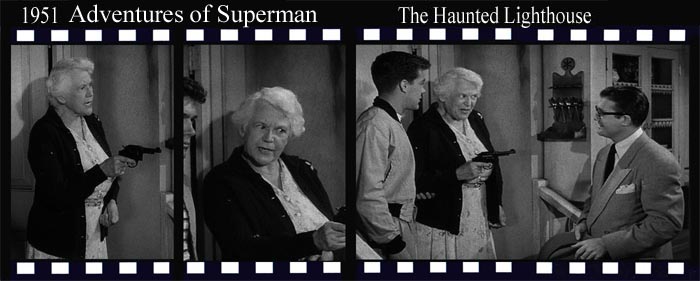 I began searching through Effie's IMDb listing, as was my habit; however, it seemed rather sparse. She had no biography to speak of, which made her even more of a mystery woman. Right off the bat, I noticed that her birth name was really Effie McLaird, born 30 July 1888 in Chatfield, Minnesota. Her spouse's name was Emory Parnell. I decided to start there.
My curiosity knew there had to be a clue as to why Effie had a mere 45 appearances between film and television in her career. While she didn't have starring roles, she appeared with some well known co-stars. Such was the case with Beneath Western Skies (1944) with Smiley Burnette and Bob Livingston (Zorro, and one of the Mesquiteers). One film review stated that "Effie Parnell (born McLaird) had only one important screen role, that of Robert Barrat's superstitious wife in Frank Wisbar's evocative Strangler of the Swamp (1945). While she had more scenes in this film, it was hardly a stellar role, despite the fact that Charles B. Middleton (Emperor Ming from the Flash Gordon serials) was among the cast. Her performances in film were, for the most part, either uncredited or miniscule. Such was the case with Two Sisters from Boston (1946). This comedy musical had the talents of Kathryn Grayson, June Allyson, Jimmy Durante and Peter Lawford, however, if you blinked, you missed Ms. Laird. In Music for Millions (1944), she teamed up with darling little Margaret O'Brien, José Iturbi, June Allyson and Jimmy Durante. Effie's two or three frames came in the last part of the film as the wardrobe mistress. Her unmistakable, authoritative voice sent the chorus dancers scurrying. I couldn't believe that her credits included It's a Wonderful Life (1946), so I had to watch the film once more. Sure enough, at the end, when all the Bedford Falls townspeople gathered at the Bailey home, Effie appeared in the crowd of folks huddled in the Bailey living room - snow on her hat and all. In House by the River (1950) she appeared with Jane Wyatt (Father Knows Best) and Sarah Padden, with whom she'd be reunited two years later. 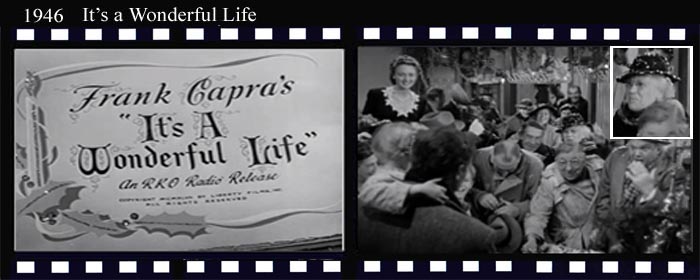 Given the fact that she had appeared in a few musicals, I thought that perhaps Effie McLaird Parnell might have been an entertainer in a different venue. I returned to her roots back in the Midwest. The 1895 Minnesota State Census indicated that Effie was the third child of four born to James Monroe Madison McLaird and Emma May (Vought) McLaird. Effie also had a half sister, Daisy (born in 1870) from her father's first wife, now deceased. Daisy was listed on that census as an insurance clerk, probably in her father's office, as he was listed as an insurance salesman. By 1900, the Census revealed that Effie's father had died (1898); her mother, Emma was a widow, head of the household and working in a laundry. Emma's son, Arthur (now 16), and daughters June (14), Effie (12), and Goldie (9) were attending school. Minnesota was one of the states that conducted its own census in between the federal poll. In 1905, Arthur was no longer living there. Emma, head of the household, was now working as a nurse and the three girls were still in school. By 1910, there was no mention of Effie McLaird on the census. Given her age, perhaps she had married and was living elsewhere. I now searched for Effie's husband, Emory Parnell. In 1900, the Parnell family had been living in St. Paul, Minnesota. James D. Parnell, Emory's dad, worked for the railroad, which was expanding through the state and parts of Canada. In all probability, the railroad expansion caused the Parnells to relocate to Willmar in Kandiyohi County. The 1910 Census confirmed this. Emory's father was listed as an agent for the railroad depot (probably a ticket agent). Emory, now 17, was a "railroad car checker" - a position for mainly bookkeeping, and maintaining samples and product supplies. Most likely, Emory worked to help pay for his future education at Morningside College in Iowa, where he trained to become a musician. I couldn't help but wonder what happened to Effie's brother Arthur. Research found that he had moved from Chatfield to Belle Fourche, South Dakota sometime between 1900 and 1907, where he met and married his wife, Laura Jane Allen. I could not locate him on the 1910 Census; however, for the 1920, he was living back in Willmar, Minnesota with his wife, Laura. On at least one occasion, Effie McLaird and her sister, June went to visit their brother in Willmar. Arthur's WW I Draft Registration Card listed him as the manager of the Merchants Hotel there, so he probably provided for their accommodations. My original theory was that Effie most likely met Emory on one of those visits to Willmar. WOMEN'S CHRISTIAN TEMPERANCE UNION (W.C.T.U.) Ms. McLaird was mentioned in the Austin Daily Herald of Minnesota, for a meeting of the Women's Christian Temperance Union (W.C.T.U.). She started out as secretary for the Minnesota chapter, and also worked in the young people's section. The W.C.T.U. concerned itself with social reform issues that included exploitation of young girls by men, substance abuse, sanitation, and women's suffrage. Mothers were encouraged to take a pledge to teach their children "the principles of total abstinence and purity." Another newspaper article from the Hendricks Pioneer, (Hendricks, MN, Nov. 23, 1911) under the heading of "Among the Churches" stated: 'Miss Effie McLaird, state secretary of the Y.C.B. branch of the Minnesota Temperance Union, will deliver an address at the Norwegian Lutheran church tonight (Thursday) at 8 o'clock. Miss McLaird is known as a convincing and entertaining speaker and the public is invited to come and hear her. No admission charged.' Ms McLaird became the organizer of the national W.C.T.U. as well as a lecturer. One of her stops had indeed been in Willmar, Minnesota. My original theory about Effie and Emory's introduction in Willmar was partially correct. They did meet in Willmar, but apparently not through her brother, Arthur. As stated in the Lyceum Magazine, (Volume 26, July 1916), it occurred because of the W.C.T.U.: "A young telegrapher working for 'Yeem Hill' refused to attend - until he met the winsome and vivacious miss. His name was Parnell, and the meeting was so interesting that pretty soon they became The Parnells, and the W.C.T.U. lost a leader - but the lyceum gained one of its finest entertainment companies." Now knowing how they met, I searched for a copy of their marriage license. Effie married Emory on August 27, 1913 at the Methodist Episcopal Church in Chatfield, Minnesota. The bride's sister, June, was her maid of honor. The 1920 Census revealed entries for Effie and Emory in two different states. The first was in New York, in the Manhattan Borough, where they rented a house at 780 W. 71st Street. Both of them were listed as singers for Lyceum. They also appeared as residents in Emory's parents' home in Willmar, Minnesota as "traveling entertainers". 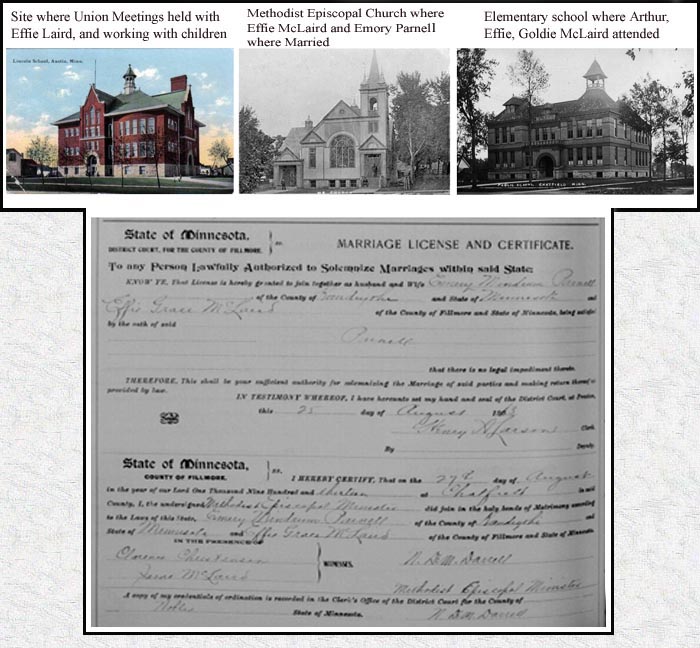
In order to comprehend what the Parnells were like as entertainers, I had to delve into their early years. The couple's show business debut began with the Chautaqua Traveling Entertainers. Emory had originally trained as a violinist and performed in concerts. The 19th century brought traveling minstrel and vaudeville acts via the Lyceum Movement to outlying districts, providing live entertainment for small towns and rural areas. The Lyceum programs also featured live speakers and debates to keep the public informed on social and political issues. Lyceum was entertainment on a small scale with one night stands. It was the precursor to what would become the Chautaqua Movement; whch featured multiple acts for one week engagements. With the Civil War over, the demand for these vaudeville and minstrel shows was on the rise. Lyceum was the predecessor to what would become the Chautaqua Movement. The Chautaqua, a Seneca Indian word translated as "two moccasins fastened together", or "a bag tied in the middle", was named after the lake in New York where Sunday school teachers were trained. As the Movement spread, regions or circuits were formed. Their focus broadened to include general education lectures on social and religious issues, much like the Lyceum. Entertainers were booked to sing spirituals, popular songs, and ballads. Ventriloquists and comedians were also among the Chautaqua. 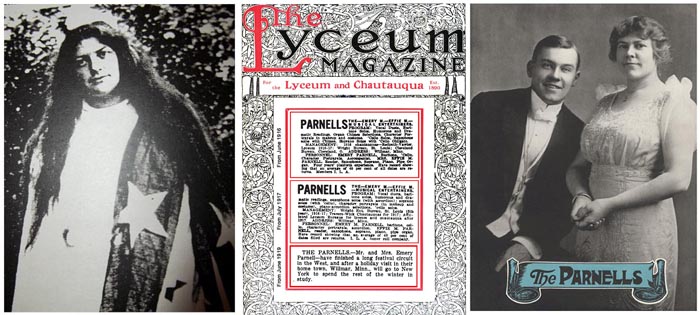
Many well known actors got their start in Vaudeville such as James Cagney, Jimmy Durante, Jack Benny, George Burns and Gracie Allen, Al Jolson, and Kate Smith to name a few. |
|
"From the local small-town stage to New York's Palace Theater, vaudeville was an essential part of every community (American Masters: Vaudeville, PBS). There were usually a dozen or more acts in every vaudeville performance. Starting and ending with the weakest, the shows went on for hours. The performances ranged from the truly talented to the simply quirky." Comedy and lighthearted entertainment was the main focus of Vaudeville. It was a venue that enabled acts like the Cohan and Foy families to take their children on the road with them. Effie did not always accompany her husband, particularly when, in 1923, the Parnells now numbered three, with the arrival of son, James Daniel. |
|
|
Curious about their act, I explored the newspaper archives. To my delight, there were numerous reviews, posters, and pamphlets of the Parnells' routine. They were seasoned veterans and lifetime members of Lyceum and Chautaqua. Emory Parnell had been dubbed the "one man band" because he simultaneously played the accordion, used his feet on the drums, at the same time playing the harmonica. He had received written accolades in the Republican Watchman, Monticello, NY, (Dec. 1923 - Jan. 1924 page 5), and Lake Geneva News, Warrensburg, NY, (Dec. 20, 1923, page 1). I then stumbled across a newspaper article for Effie in the Portsmouth Herald in New Hampshire, (January 30, 1925 on page 5), mentioning "Mrs. Effie Laird in her solo 'Star O' Robbie Burns' was especially fine. The song was excellently rendered and well received with deep appreciation. As an encore Mrs. Laird favored with 'Lassie O' Mine." On the front page of the July 17, 1931 edition of the Humboldt Republican, Iowa, the headline read CHAUTAQUA HERE AUG. 1-5. Beneath the subheading of "Parnells Open Season", the article mentioned the fame of Emory. The second paragraph referenced his wife: "This year Mrs. Effie M. Parnell accompanies her husband and adds much to the program with her vocal instrumental selections in solo and duet work." 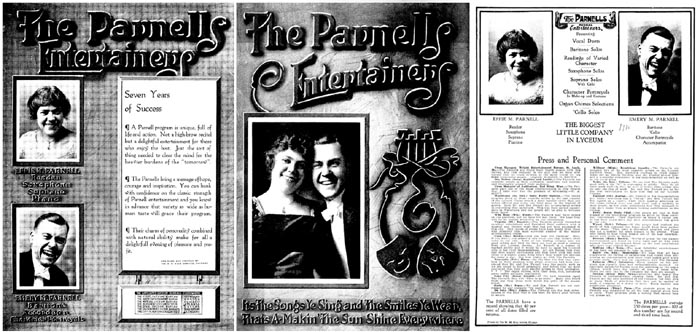 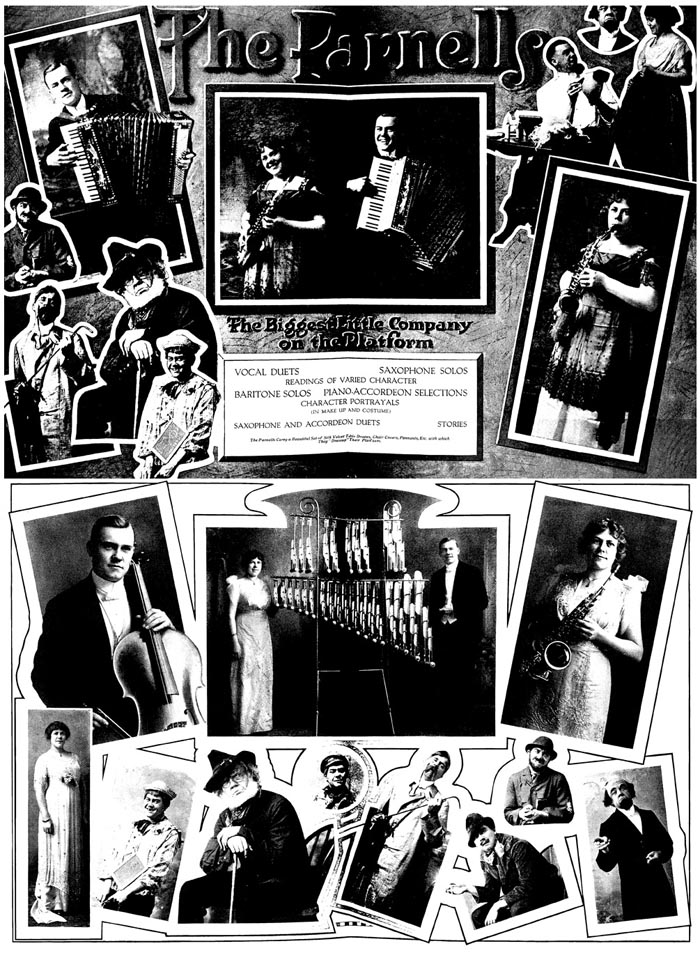 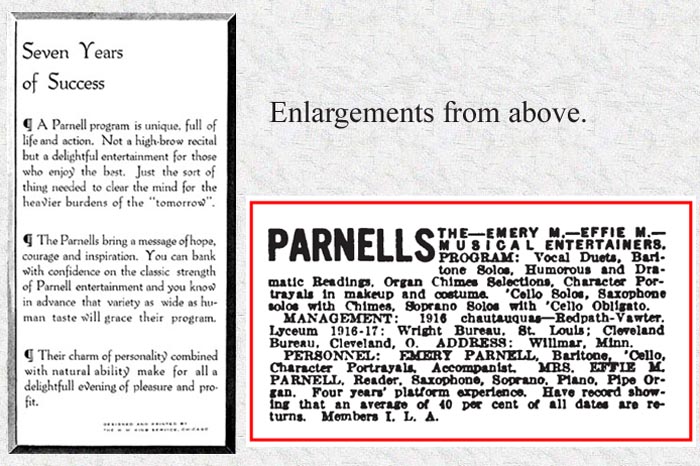 |
|
The Adventures Continue (TAC) is a website devoted to George Reeves and the Adventures of Superman. All contents copyright© by Jim Nolt unless otherwise noted. All rights reserved. Nothing from this website may be reproduced by any means, in whole or in part (excpet for brief passaged used solely for review purposes) without the written permission of either Jim Nolt (owner) and/or Lou Koza (editor). The items contained in the feature pages titled Effie McLaird Parnell by Colete Morlock is the copyright and ownership of Colete Morlock and cannot be reproduced by any means, in whole or in part without Ms. Morlock's written permission. Superman and all related indicia are trademarks of DC Comics, Inc. and are reproduced for historical purposes only. Use of the name of any product or character without mention of trademark status should not be construed as a challenge to such status. Includes the video captures from the Adventures of Superman. |